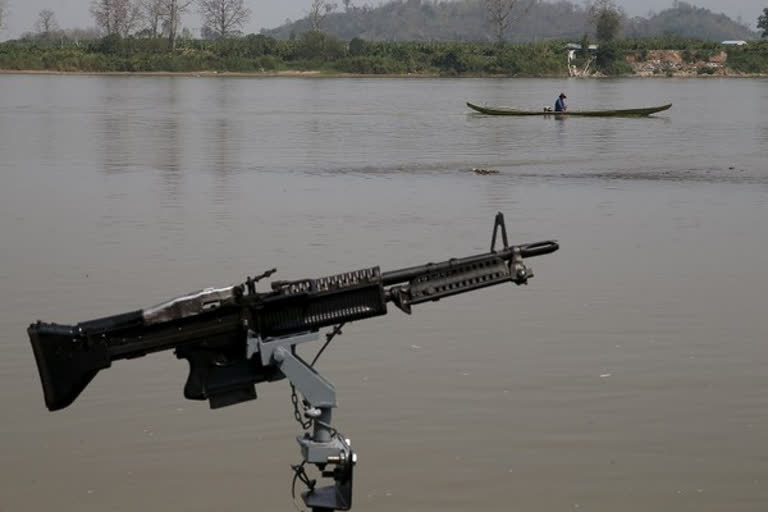Hong Kong: Imagery from 1 February's Myanmar coup brought a reminder of the success that China's arms exports have had in many parts of the world. Pictures from the coup showed Chinese-built WMA301 6x6 assault guns on Myanmar streets, for instance. Indeed, China is currently the fifth-largest arms exporter in the world.
China has been gaining footholds in new markets too. Data from the Stockholm International Peace Research Institute (SIPRI) stated that from 2010-14 China sold to 40 different markets, but in the 2015-19 period, it had risen to 53 different countries. From 2005-09 till 2010-14, Chinese weapon sales snowballed an astonishing 133 per cent, though it has calmed down significantly since then.
From 2015-19, Asia and Oceania represented the majority of Chinese weapon sales (74 per cent), with another 16 per cent going to Africa and 6.7 per cent to the Middle East. Pakistan has been China's largest export market since 1991, and when the USA stopped providing military aid to Islamabad, this only increased Pakistani reliance on China as its main supplier. Thus, 73 per cent of Pakistani arms purchases came from China in the 2015-19 period.
China enjoyed a 5.5 per cent share of the global arms market from 2015-19, and SIPRI data revealed that its three biggest export markets from 2015-19 were Pakistan (35 per cent of Chinese sales), Bangladesh (20 per cent) and Algeria (9.9 per cent).
Read:|China pushes weapons into Myanmar, India; threatens regional security
Significantly, China was still the fifth-largest importer of arms in 2019, most of this being equipment acquired from Russia (76 per cent of its arms imports), principally Su-35 fighters, S-400 surface-to-air missiles (SAM) systems and fighter jet engines.
Last December, SIPRI released a report entitled "Mapping the International Presence of the World's Largest Arms Companies". It stated that arms sales by the globe's 25 largest defence companies had risen 8.5 per cent to USD361 billion in 2019. The position of the top five arms companies - all American: Lockheed Martin, Boeing, Northrop Grumman, Raytheon and General Dynamics - is not in jeopardy, but four Chinese companies appear in the top 25 globally. These are the Aviation Industry Corporation of China (AVIC, with a ranking of 6th); China Electronics Technology Group Corporation (CETC, ranked 8th); China North Industries Group Corporation (NORINCO, ranked 9th); and China South Industries Group Corporation (CSGC, ranked 24th).
From 2018 to 2019, the arms sales of these four Chinese companies rose by 4.8 per cent. The SIPRI researchers acknowledged that the lack of accurate data from China is problematic and that other Chinese companies could be among the top 25 arms companies. One example could be the China State Shipbuilding Corporation (CSSC).
AVIC's weapon sales in 2019 amounted to USD22.47 billion, up 2.7 per cent from a year earlier. CETC's arms exports in 2019 totalled USD15.09 million, only just eclipsing NORINCO's USD14.54 billion. CETC enjoyed an 11 per cent growth year on year, whereas NORINCO slipped 0.3 per cent. As for CSGC, it achieved arms sales of USD4.61 billion in 2019, a leap of 12 per cent compared to 2018.
However, despite spreading their reach, Chinese companies are still selling only to a limited range of customers. North American, West European and Australasian markets are not interested in Chinese weapons, with a total lack of military cooperation between the blocs. Indeed, Siemon Wezeman, a senior researcher at SIPRI, said: "The Chinese and Russian arms companies in the top 15 have only a limited international presence. Sanctions against Russian firms and government-mandated limits on acquisitions by Chinese firms seem to have played a role in constraining their global presence."
Read:|China's first Hualong One nuclear reactor begins operations
AVIC is known to have foreign entities in at least six countries, including Cambodia, Finland, Pakistan, Spain, the UK, and the USA. For instance, AVIC's China Aviation Planning and Design Institute are present in both Cambodia and Pakistan. AVIC's presence in Western countries "do not appear to correspond to an attempt to develop an international presence per se as they remain fairly limited in scope," SIPRI said, although it did note there was an intention to acquire Western technologies.
China's arms industry is almost entirely state-owned. Of course, in a country with such a centralised government as China, this means every weapon sale is done with Beijing's approval and to ensure it aligns with government policy. Certainly, it is common knowledge that China has little compunction about selling to non-state actors (a prime example is the United Wa State Army in Myanmar) as well as to the autocratic regimes or places where civil war is rife.
Beijing knows that arms are a strategic commodity, for they inexorably tie a client state to China. Long after an initial purchase has been made, militaries will need technical support, spare parts and more ammunition, thus ensuring that a long-term dependency is achieved. This also explains why India was so keen to donate one of its much-cherished submarines to Myanmar, for it was to prevent China from gaining a strategic foothold with a submarine fleet in the Southeast Asian nation.
With the West increasingly wary of Chinese ambition and activity, it is becoming more difficult for Chinese companies to pursue dual-use technologies too. The backlash against Huawei 5G networks is one example of this caution, especially since every Chinese company - whether it is privately owned or not - is legally obliged to share data with the Chinese government at its request.
